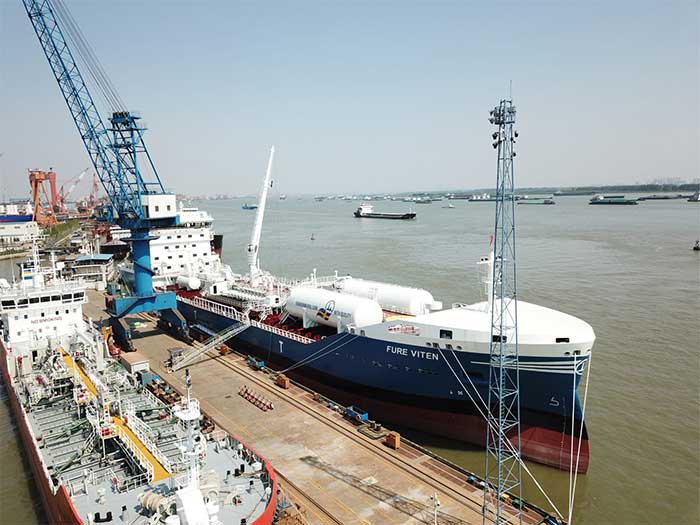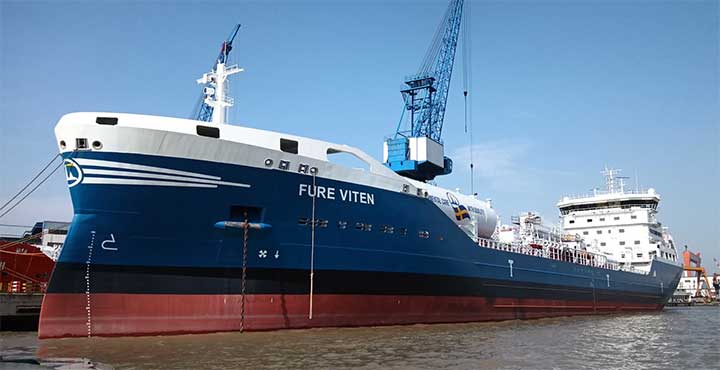
Furetank’s latest delivery meets IMO 2050 target today
Written by Nick Blenkey
Fure Viten alongside at the shipyard [Image: Furetank]
Donsö, Sweden, based Furetank says that its latest delivery, the Fure Viten is the best in class globally in terms of meeting IMO’s climate goals for shipping. Thanks to gas fueling and a unique combination of fuel-saving solutions, it reaches a very low EEDI (energy efficiency design index) value of 4.65. A lower EEDI number means lower emissions. The current requirement for a vessel the size of the 17,999 dwt Fure Viten is to reach below 9.37 points, but with its low EEDI of 4.65 points, Fure Viten already meets the emission targets for 2050.
“We will operate the ships we build now for the coming 20 years, so we have put a lot of effort into investigating what is the best possible technology that we can invest in today,” says Lars Höglund, CEO of Furetank. “Climate change is a reality and we believe that politicians mean what they say. Thus, if we are to survive as a shipping company in the future, we must do our absolute best to reduce our climate and environmental impact.”
ALL SYSTEMS ENERGY-OPTIMIZED
Built at China Merchants Jinling Shipyard Dingheng Co Ltd., Fure Viten is the latest vessel in a series of eight vessels so far, four owned by Furetank and all commercially managed by the company.
The series has been designed by Furetank and FKAB Marine Design in collaboration with Wärtsilä, with the aim of reducing fuel consumption as much as possible. Throughout the design and construction process, energy efficiency has been increased and the EEDI value improved.
“We have developed ships since the 80’s and used our entire experience to optimize every detail. There is not a single system that we haven’t improved,” says Höglund. “This combination of interacting, energy-saving technical solutions is unique.”
As examples of this interaction, batteries help reduce the use of auxiliary engines, a ducted propeller increases thrust and reduces power requirement, an improved hull shape minimizes drag, and the main engine and shaft generator use variable frequency to increase propeller efficiency and reduce fuel consumption.
GAS FUELING BENEFITS
The eight dual-fuel vessels will be operated with LBG (liquefied biogas) or LNG (liquefied natural gas), providing major climate, environmental and health benefits compared to oil. In combination with the technical optimizations, emissions of carbon dioxide have been reduced by 55% compared to older vessels and NOx emissions by 86%. Emissions of SOx and particles (PM) are basically completely eliminated.
“The next step will be to operate the ships completely without fossil fuels,” says Höglund. “We are in the process of securing the supply of larger quantities of biogas within a year or so, through an exclusive agreement with a supplier. My view is that in 2030 we will run these vessels largely on LBG with zero fossil emissions.”
FIRST IN EUROPE WITH FULL SHORE POWER
Fure Viten and preceding sister vessel Fure Vinga are the first tankers in Europe that are fully equipped to operate their energy-demanding cargo pumps with 6.6 kV high voltage shore power. This will reduce emissions even further as soon as ports offer the opportunity.
The solution is being developed in collaboration with the ports of Gothenburg and Rotterdam, currently in the process of developing the full capacity power connection required to operate the pumps. This is an important effort, as the emissions in port can account for up to 20% of the total emissions from a tanker, in an environment that is often even more sensitive to pollution and noise than at sea.
Family owned Furetank operates nine owned vessels and is a founding member of the Gothia Tanker Alliance, a pioneer in LNG fueling of tankers.
Last September, another Furetank vessel, Fure Ven, became the first foreign-flag ship to bunker LNG in the U.S.





